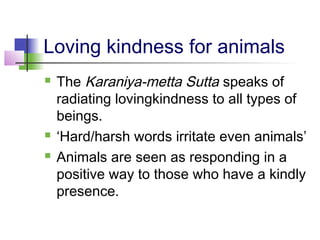
Buddhist attitude to animal
- 1. Loving kindness for animals The Karaniya-metta Sutta speaks of radiating lovingkindness to all types of beings. ‘Hard/harsh words irritate even animals’ Animals are seen as responding in a positive way to those who have a kindly presence.
- 2. Both humans and animals respond better to those who they feel are friendly, so that loving-kindness is seen to protect a person. Animals are seen as responding in a positive way to those who have a kindly presence.
- 3. ’In the Theravadin monastic code, monks are allowed to release trapped animals or fish, if this is from compassion rather than a desire to steal (Vin III.62-63). Gotama saved a goose which his cousin Devadatta had shot with an arrow, and went on to nurse it back to health
- 4. the Brahmajala Sutra says: ‘One should be willing to forsake one’s entire body, one’s flesh, hands and feet as an offering to starving tigers, wolves, lions, and hungry ghosts. Altruism towards animals can also be at a very simple level: it is karmically fruitful even to throw dishwater into a pool or cesspit for insects and other creatures to feed on (A. I.161).
- 5. Among the charitable deeds of the emperor Asoka was the planting of medicinal herbs, and the development of wayside wells and shadetrees, for both humans and animals . This accords with one of the duties of compassionate Cakkavatti: protecting animals and birds
- 6. Buddhism also regards the liberating of animals from death as a karmically fruitful act. In Buddhism, particularly at the time of certain festivals or holy days, crabs are returned to the sea, birds are released to the sky, and chickens are saved from slaughter.
- 7. Livestock are sometimes released into the care of large monasteries, perhaps with contributions for their upkeep. Such monasteries may also have a pool for fish rescued from fishmongers.
- 8. In Buddhist countries, people feed the protected turtles and fish at monasteries, and it is seen as good to rescue fish from pools that are drying out, and to transfer them to a river.
- 9. At certain festivals, people also buy birds from traders, so as to do the good deed of releasing them. An unfortunate side-effect of this custom, though, is that birds are deliberately captured for this purpose!
